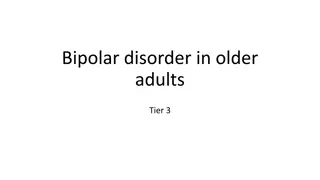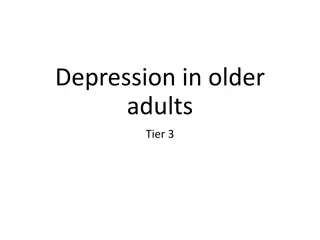Understanding Late-Life Depression: Causes, Prevalence, and Diagnosis
Late-life depression is a prevalent condition among older adults, with factors such as personal history, medical comorbidities, and lack of social support contributing to its onset. This article discusses mood disorders, prevalence rates, risk factors, and differential diagnosis for depressed mood in the elderly. Screening tools like the Geriatric Depression Scale and Mood Disorder Questionnaire are highlighted for assessment. Treatment options and the importance of early detection are also explored.
Download Presentation

Please find below an Image/Link to download the presentation.
The content on the website is provided AS IS for your information and personal use only. It may not be sold, licensed, or shared on other websites without obtaining consent from the author. Download presentation by click this link. If you encounter any issues during the download, it is possible that the publisher has removed the file from their server.
E N D
Presentation Transcript
Late-Life Depression Andrew Baumgartner, MD Assistant Professor Department Of Psychiatry University of Nebraska Medical Center
Objectives Review mood and mood disorders Identify causes and contributors to late-life depression Discuss treatment options for late-life depression
Mood A sustained and pervasive emotional state, a kind of feeling Dysphoria = low or uncomfortable mood Euthymia = normal mood euphoria = elevated mood
Mood Disorder Prolonged or episodic abnormal mood Example from DSM 5 - Major Depressive Episode Two weeks or more with depressed mood and/or anhedonia plus at least 3-4 of the following Sleep changes Negative feelings Low energy Concentration difficulties Appetite changes Psychomotor changes Thoughts of death or suicide
Prevalence Of Late-Life Depression Any depressive symptoms/subsyndromal depression 11% 12-month prevalence of Major Depressive Disorder (MDD) 3-4.5% Increases with illness burden Primary care 5-10% Acute hospital 11.5% Nursing homes 14.4%
Risk Factors For Late-Life Depression History of previous depressive/mood episodes Family history of mood disorders Substance use Medical comorbidities Acute Subacute Chronic Female Socioeconomic status Lack of social supports
Differential Diagnosis For Depressed Mood Mood disorders MDD Bipolar disorder, current mood depressed or mixed Anxiety disorders Posttraumatic Stress Disorder Substance/Medication induced Cognitive changes Medical conditions Psychosocial factors Personality factors Transitions Life stage Interpersonal
Screening Geriatric Depression Scale Preferred for older adults with cog changes due to yes/no Short and long PHQ (2 or 9) Free, quick, not designed for older adults, but good enough and more sensitive for DSM MDD Mood Disorder Questionnaire (MDQ) Good specificity but low sensitivity for bipolar 1 If suggestive of bipolar... Widely available online
Treatments Psychotherapy Medications Interventional
Psychotherapy Cognitive Behavioral Therapy Goal setting Behavioral activation Cognitive reframing Others Interpersonal Brief psychodynamic Acceptance and commitment Life review/reminiscence
Medications SSRIs Sertraline Citalopram Escitalopram SNRIs Venlafaxine Duloxetine Mirtazapine Bupropion
Other Interventions Electroconvulsive Therapy Psychotic depression Catatonia Transcranial Magnetic Stimulation Esketamine























